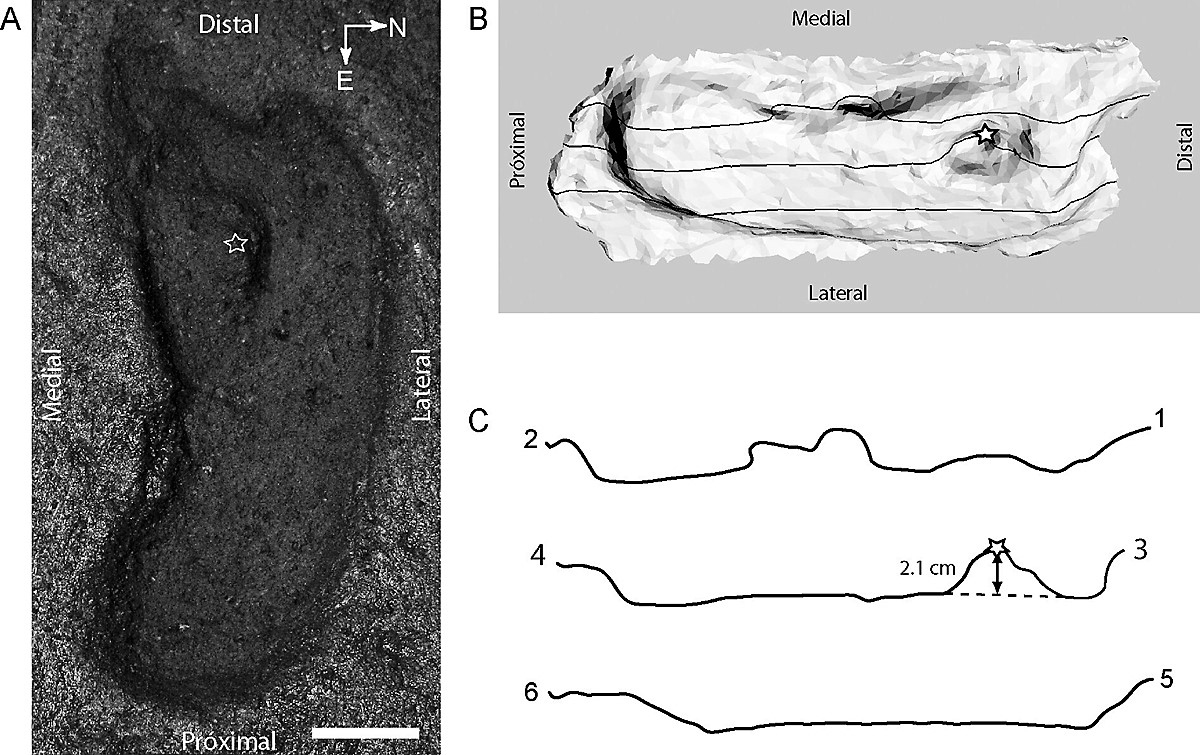


An article on phys.org - Footprint found in Chile is 'oldest' in Americas - reports on the recent analysis by scientists in Chile of a footprint dating from at least 15,600 years ago, making it the earliest such sign of human presence in the Americas.

The footprint was found at the Pilauco excavation in the city of Osorno, south of Santiago, where scientists have been digging since 2007. Archeologists from the Austral University of Chile said the footprint was first spotted in 2011 but it has not been until recently that paleontologist Karen Moreno and geologist Mario Pino have been able to confirm that the print is human, and that it is the oldest in the Americas yet known. This was carried out by applying radiocarbon dating techniques to organic plant material where the print was found.
Pino explained the footprint appears to be that of a barefoot man weighing about 70 kilograms and of the species Hominipes modernus, a relative of Homo sapiens.
The area in Chile has proven rich in fossils, including evidence of an ancestor of today's elephants and horses, as well as of more recent human presence.
The newer findings were published in the latest edition of the peer-reviewed scientific journal PLOS One:
- Karen Moreno et al
- Published: April 24, 2019. DOI: 10.1371/journal.pone.0213572
Abstract
The present study describes the discovery of a singular sedimentary structure corresponding to an ichnite that was excavated at the paleo-archaeological site Pilauco (Osorno, Chile). The trace fossil is associated with megafauna bones, plant material and unifacial lithic tools. Here we present a detailed analysis of the Pilauco ichnite and associated sedimentary structures, as well as new radiocarbon data. The ichnological analysis confidently assigns the trace to the ichnospecies Hominipes modernus a hominoid footprint usually related to Homo sapiens. Some particular characteristics of the Pilauco trace include an elongated distal hallux, lateral digit impressions obliterated by the collapsed sediment, and sediment lumps inside and around the trace. In order to evaluate the origin of the ichnite, trackmaking experiments are performed on re-hydrated fossil bed sediments. The results demonstrate that a human agent could easily generate a footprint morphology equivalent to the sedimentary structure when walking on a saturated substrate. Based on the evidence, we conclude that the trackmaker might well have been a bare-footed adult human. This finding, along with the presence of lithic artifacts in the same sedimentary levels, might represent further evidence for a pre-Clovis South American colonization of northern Patagonia, as originally proposed for the nearby Monte Verde site.
Commentby Bradshaw Foundation
Tuesday 21 March 2023
by Bradshaw Foundation
Tuesday 07 February 2023
by Bradshaw Foundation
Thursday 19 May 2022
by Bradshaw Foundation
Tuesday 19 October 2021
by Bradshaw Foundation
Friday 25 June 2021
by Bradshaw Foundation
Monday 09 November 2020
by Bradshaw Foundation
Tuesday 03 November 2020
by Bradshaw Foundation
Wednesday 28 October 2020
by Bradshaw Foundation
Tuesday 23 June 2020
by Bradshaw Foundation
Thursday 04 June 2020
by Bradshaw Foundation
Thursday 14 May 2020
by Bradshaw Foundation
Tuesday 12 May 2020
by Bradshaw Foundation
Wednesday 19 February 2020
by Bradshaw Foundation
Tuesday 21 January 2020
by Bradshaw Foundation
Monday 20 January 2020
by Bradshaw Foundation
Thursday 28 November 2019
by Bradshaw Foundation
Tuesday 21 March 2023
by Bradshaw Foundation
Tuesday 07 February 2023
by Bradshaw Foundation
Thursday 19 May 2022
by Bradshaw Foundation
Tuesday 19 October 2021
by Bradshaw Foundation
Friday 25 June 2021
by Bradshaw Foundation
Monday 09 November 2020
by Bradshaw Foundation
Tuesday 03 November 2020
by Bradshaw Foundation
Wednesday 28 October 2020
by Bradshaw Foundation
Tuesday 23 June 2020
by Bradshaw Foundation
Thursday 04 June 2020
by Bradshaw Foundation
Thursday 14 May 2020
by Bradshaw Foundation
Tuesday 12 May 2020
by Bradshaw Foundation
Wednesday 19 February 2020
by Bradshaw Foundation
Tuesday 21 January 2020
by Bradshaw Foundation
Monday 20 January 2020
by Bradshaw Foundation
Thursday 28 November 2019
Friend of the Foundation











